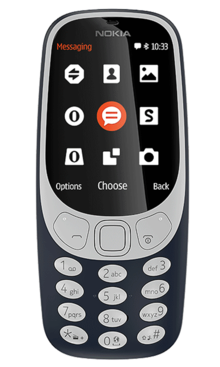Feature phone
Prior to the popularity of smartphones, the term 'feature phone' was often used on high-end mobile telephones with assorted functions for retail customers, developed at the advent of 3G networks, which allowed sufficient bandwidth for these capabilities.
Several models are equipped with hardware functions; such as FM radio and flashlight, that prevent the device from becoming useless in the event of a major disaster, or entirely obsolete, if and when 2G network infrastructure is shut down.
[2] In developed economies in the mid 2000s to early 2010s, fashion and brand loyalty drove sales, as markets had matured and people moved to their second and third phones.
In the United States, technological innovation with regard to expanded functionality was a secondary consideration, as phone designs there centred on miniaturisation.
[9][10][11] Existing feature phone operating systems at the time were not designed to handle additional tasks beyond communication and basic functions, and due to the complex bureaucracy and other factors, they never developed a thriving software ecosystem.
[14][15] The shift away from feature phones has forced mobile network operators to increase subsidies of handsets, and the high selling-prices of flagship smartphones have had a negative effect on the mobile network operators, who have seen their earnings before interest, taxes, depreciation, and amortisation (EBITDA) margins drop as they sold more smartphones and fewer feature phones.
[19] During the mid-2000s, best-selling feature phones such as the fashionable flip-phone Motorola Razr, multimedia Sony Ericsson W580i, and the LG Black Label Series not only occupied the mid-range pricing in a wireless provider's range, they made up the bulk of retail sales as smartphones from BlackBerry and Palm were still considered a niche category for business use.
The survey found that smartphone owners tend to be male, younger, live in a high-income household with children in the home, and residents of a community of one million or more people.
[32] Other platforms which saw significant adoption at this time include Qualcomm's Binary Runtime Environment for Wireless, abbreviated as BREW, and Adobe's Flash Lite.



